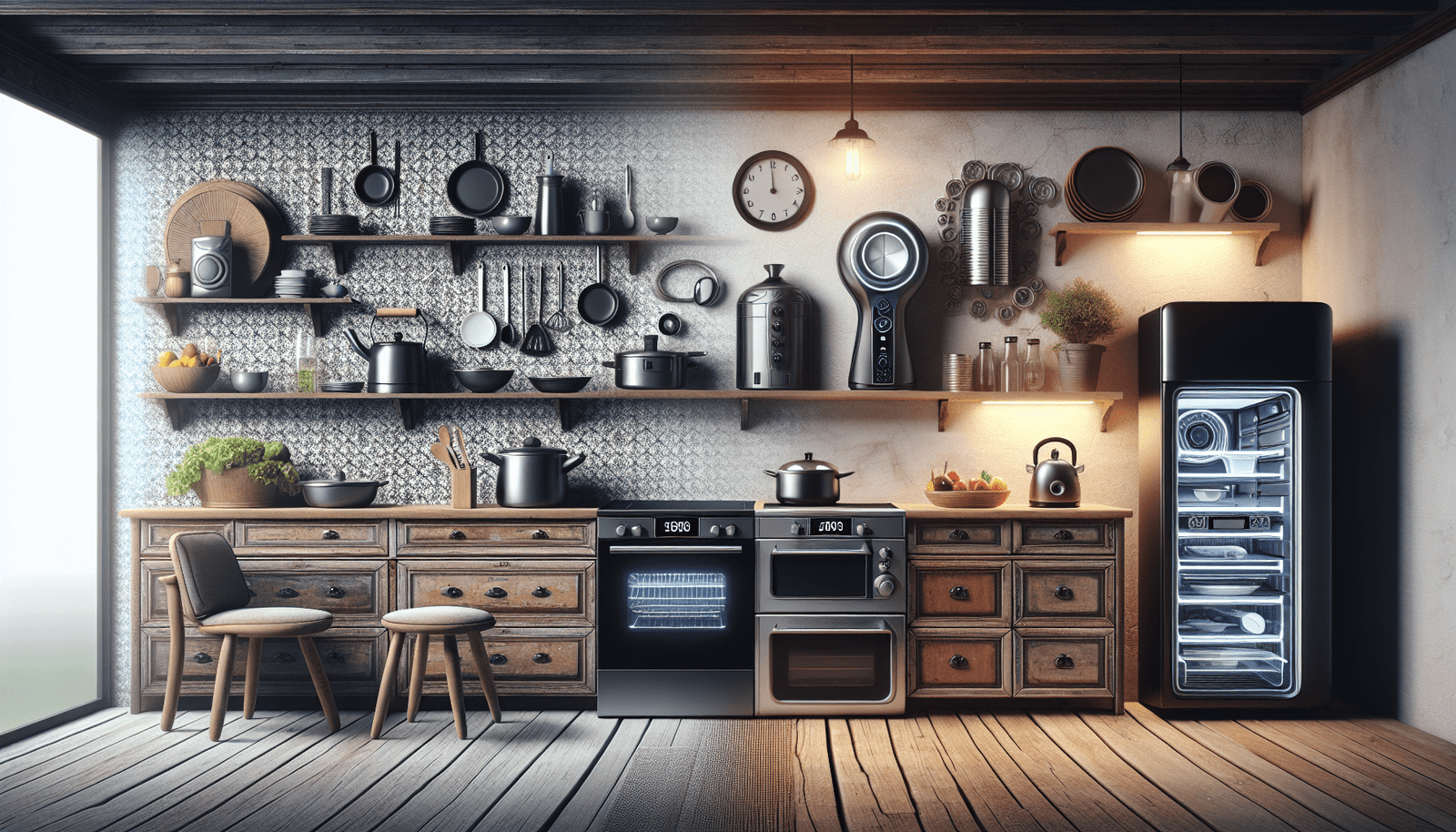Step into a world where culinary creativity and convenience converge – the modern kitchen. From its humble beginnings as a simple hearth to today’s sleek and efficient spaces, the transformation of the kitchen has been nothing short of remarkable. In this article, you will embark on a journey through time to explore the fascinating evolution of the modern kitchen, tracing its origins, highlighting the key advancements, and marveling at the innovations that have reshaped the heart of the home. So, grab your apron and tighten your chef’s hat as we uncover the captivating tale of how the kitchen has evolved into a culinary haven.

Pre-Industrial Era
Introduction of fire
In the pre-industrial era, fire played a crucial role in cooking. It was a monumental discovery that revolutionized the way our ancestors prepared their meals. Fire not only provided heat but also allowed our early ancestors to cook their food, making it easier to digest and enhancing its taste. The introduction of fire as a cooking tool marked the first step towards the development of the modern kitchen.
Hearth as the primary cooking area
During this era, the hearth became the heart of every home. The hearth was a raised area where fire was kept alive, providing a central gathering place for cooking, warmth, and social interaction. It served as the primary cooking area, where food was prepared in pots and pans directly placed over the fire. The hearth not only served its functional purpose but also became a symbol of warmth and togetherness in the family.
Storage of food
In the pre-industrial era, storage of food was a challenge due to the lack of proper preservation techniques. Families relied heavily on perishable ingredients, making it necessary to consume the food quickly. To tackle this issue, food storage methods such as drying, smoking, pickling, and salting were employed. These methods helped to extend the shelf life of food, allowing families to store provisions for longer periods. Food was commonly stored in vessels made of clay, wood, or animal skins.
Minimal utensils and tools
During this era, kitchen utensils and tools were limited in number and simplicity. Cooking involved the use of basic tools such as wooden spoons, knives, and primitive grinding stones. These utensils were mainly crafted from natural materials readily available in the environment. The simplicity of the utensils and tools reflected the minimalistic lifestyle of the time, where practicality outweighed extravagance.
Industrial Revolution
Advancements in cooking technology
The advent of the Industrial Revolution in the 18th century brought about significant advancements in cooking technology. With the rise of industrialization, new cooking tools and equipment were developed, making the cooking process more efficient and convenient. This period marked a turning point in the history of the kitchen, as innovations continued to shape the way we cook and prepare our food.
Introduction of cast iron stoves
One of the significant breakthroughs of the Industrial Revolution was the introduction of cast iron stoves. These stoves replaced the traditional hearth, providing a more controlled and efficient heat source. Cast iron stoves allowed for precise temperature regulation, ensuring that food was cooked evenly and thoroughly. This innovation not only simplified the cooking process but also improved the overall quality of food.
Improvements in food storage
During the Industrial Revolution, advancements in food storage techniques took place. The discovery of canning, pioneered by Nicolas Appert, revolutionized food preservation. Canning involved sealing food in airtight containers, preventing spoilage and extending shelf life. This breakthrough allowed food to be stored for longer periods, reducing the reliance on perishable ingredients and enabling families to have access to a more diverse range of foods.
Increasing role of women in the kitchen
As industrialization progressed, more women began to work outside the home. This shift resulted in a transformation of the household dynamic, particularly in the kitchen. Traditionally, women were primarily responsible for cooking and managing the kitchen, but with the rise of industrialization, their roles expanded beyond domestic responsibilities. However, even as women ventured into the workforce, they still played a crucial role in the kitchen, adapting to the changing times and balancing their professional and household duties.
The 20th Century
Introduction of gas and electric stoves
The 20th century saw a significant shift in cooking technology with the introduction of gas and electric stoves. Gas stoves, which became popular in the early 1900s, offered a cleaner and more controllable heat source compared to solid fuel stoves. Electric stoves, on the other hand, gained popularity later in the century, offering even greater convenience and precision in temperature control. The introduction of these stoves transformed the cooking experience, making it safer, quicker, and more efficient.
Innovation in kitchen appliances
The 20th century witnessed a surge in innovation, particularly in the development of kitchen appliances. Appliances such as refrigerators, blenders, toasters, and mixers were introduced, making tasks such as food storage, blending, toasting, and mixing significantly easier. These appliances streamlined the cooking process, freeing up time and reducing the effort required in food preparation.
Emergence of modular kitchens
In the 20th century, the concept of modular kitchens emerged. Modular kitchens introduced the idea of designing kitchen spaces with standardized units or modules, making it easier to install, maintain, and customize the layout. This concept allowed for greater flexibility and efficiency in kitchen design, providing homeowners with the option to optimize their kitchen space according to their needs and preferences.
Changing kitchen layout and design
The 20th century saw a shift in kitchen layout and design. The functional and utility-focused kitchens of the past were transformed into more aesthetically pleasing and ergonomic spaces. The introduction of new materials, such as stainless steel and laminate, allowed for greater durability and ease of maintenance. The layout of the kitchen also evolved, with the incorporation of work triangles and efficient organization of appliances, countertops, and storage spaces.
Post-War Era
Technological advancements in kitchen appliances
Following the end of World War II, the post-war era witnessed rapid technological advancements in kitchen appliances. Manufacturers focused on improving the efficiency and performance of appliances, resulting in appliances that were faster, more reliable, and easier to use. Dishwashers, microwave ovens, and automatic coffeemakers became popular during this period, further revolutionizing the way we cook and prepare food.
Focus on convenience and efficiency
In the post-war era, there was a strong emphasis on convenience and efficiency in the kitchen. Manufacturers aimed to simplify the cooking process by creating appliances and gadgets that made tasks quicker and easier. Automatic timers, self-cleaning ovens, and programmable appliances became standard features, allowing for greater convenience and time-saving capabilities.
Rise of kitchen gadgets and utensils
The post-war era witnessed the rise of kitchen gadgets and utensils designed to make cooking more efficient and enjoyable. Can openers, food processors, electric mixers, and other innovative tools became popular, further reducing the manual effort required in food preparation. These gadgets not only saved time but also allowed for more precise and consistent results in cooking and baking.
Introduction of frozen and processed foods
During the post-war era, frozen and processed foods gained popularity as a result of technological advancements in food preservation techniques. The introduction of frozen foods, such as TV dinners and frozen vegetables, provided a convenient and time-saving alternative to traditional cooking. Processed foods, such as canned soups and pre-packaged meals, became staples in many households, offering quick and easy meal options.

The Modern Kitchen
Incorporation of technology in every aspect
In the modern kitchen, technology plays a vital role in every aspect of cooking and food preparation. Smart appliances, such as refrigerators with built-in screens and voice-controlled ovens, have become commonplace. These appliances integrate technology to enhance functionality and provide a seamless user experience. From recipe-guided cooking to automated inventory management, technology has transformed the way we interact with our kitchen.
Increasing emphasis on sustainability
With growing concerns about the environment, the modern kitchen has seen an increasing emphasis on sustainability. Energy-efficient appliances, recycling solutions, and composting systems have become integral parts of eco-friendly kitchen designs. The focus on sustainability extends beyond the appliances, with an emphasis on using organic and locally sourced ingredients, reducing food waste, and adopting eco-friendly practices in the kitchen.
Integration of smart appliances and IoT
The integration of smart appliances and the Internet of Things (IoT) has revolutionized the modern kitchen. Smart refrigerators can create shopping lists, track inventory, and provide recipe suggestions based on the available ingredients. Connected cooking devices allow for remote monitoring and control, ensuring that meals are cooked to perfection even when you’re not in the kitchen. The modern kitchen has become an interconnected ecosystem, where appliances work together seamlessly to enhance the cooking experience.
Open-concept kitchen design
Open-concept kitchen design has gained popularity in recent years. The modern kitchen is no longer a separate, enclosed space but has become a part of the overall living area. Open layouts allow for better social interaction, making the kitchen a central hub for gatherings and entertaining. This design trend also maximizes natural light and offers a sense of spaciousness, creating a welcoming and inviting atmosphere.
As we reflect on the evolution of the modern kitchen, it is clear that advancements in technology, changes in societal roles, and shifts in design aesthetics have all played a role in shaping what our kitchens look like today. From the humble hearth of the pre-industrial era to the smart, sustainable kitchens of the present, our journey in the realm of cooking and food preparation continues to evolve, enhancing our everyday lives and bringing people together.

